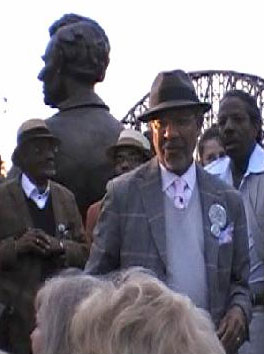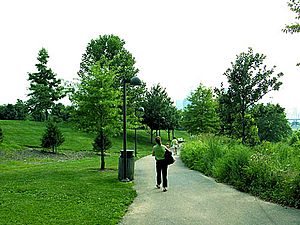Lincoln Memorial at Waterfront Park facts for kids
The Lincoln Memorial at Waterfront Park is a special statue of Abraham Lincoln. It shows him as a young man, before he became the President of the United States. In this sculpture, Lincoln is bareheaded and sitting on a rock. He holds an open law book in one hand. His other hand is open, as if welcoming you.
You can find this statue at Waterfront Park in Louisville, Kentucky. It is part of the Lincoln Heritage Trail, which connects places important to Lincoln's life. The statue and its story panels were made by an American artist named Ed Hamilton. The park's design was created by Hargreaves Associates. The state of Kentucky helped pay for the memorial in 2006, and people also gave money to support it.
Contents
Abraham Lincoln's Statue: A Young Leader
In 2009, sculptor Ed Hamilton finished his artwork of Abraham Lincoln. Lincoln was the 16th President of the United States. This statue was dedicated during a two-year celebration of Lincoln's 200th birthday. It was made to show how Lincoln felt about slavery. He saw slave markets in Louisville when he was young.
The statue and the story panels (called bas-reliefs) show Lincoln's strong dislike for slavery. They also highlight how his presidency and the city of Louisville played a part in the Civil War. This war saved the United States and ended slavery.
Story Panels: Lincoln's Journey and Slavery
The Lincoln Memorial at Waterfront Park includes special story panels. These are called bas-reliefs and were also created by Ed Hamilton. They tell the history of slavery. Hamilton showed these panels at the same time the Lincoln statue was dedicated in 2009.
The panels are placed side-by-side along a path leading to the statue. They have text and pictures that show different times in Lincoln's life.
- The first panel talks about Lincoln's childhood.
- The second panel shows how slavery and the Civil War divided even Lincoln's own family.
- The third panel explains how Lincoln became more aware of political and social issues.
- The fourth and last panel shows seven enslaved people chained together. It includes a quote from Lincoln. He wrote about how much he came to hate slavery after seeing enslaved people loaded onto a boat in Louisville.
Words from Lincoln are carved into the granite of the amphitheater nearby. One famous quote says, "As I would not be a slave, so I would not be a master."
Meet the Sculptor: Ed Hamilton
Ed Hamilton learned his skills from another Louisville sculptor, Barney Bright. Bright was famous for his work on the Louisville Clock. From May to December 2002, the Speed Art Museum in Louisville held an exhibition of Hamilton's sculptures. It was called From the Other Side.
Hamilton also designed a monument for African-American Civil War soldiers in Washington, D.C. He also created another Lincoln statue at Centre College in Danville, Kentucky. When talking about the Lincoln sculpture in Louisville, Hamilton said he wanted to show Lincoln as an ordinary person. He wanted to show him as "a man of the people."
Hamilton explained his vision: "I didn't want to do another Lincoln like all the other Lincolns...I wanted (it) to be a Lincoln of the people...And so my vision was...I thought wouldn't it be interesting to have him, say a morning time walking to the office...And all of a sudden he came upon this big boulder, and he just took a notion to sit down. And he set his books and his top hat on the boulder, and he started reading one of his books. And all of a sudden, someone caught his attention and with a gesture of saying 'Hey! Come, sit down. Welcome...'"
Waterfront Park: A Place to Explore
The Lincoln Memorial statue is located inside Louisville Waterfront Park. This is a city park right by the Ohio River. Waterfront Park is part of the Louisville Riverwalk and the Kentucky Lincoln Heritage Trail.
When the park was designed, they planted trees that Lincoln liked. The park's dedication was on June 3, 2009. There was a public event at sunset. A 50-piece orchestra played music by American composer Aaron Copland. A Louisville native, William Mapother, narrated Copland's Lincoln Portrait.



